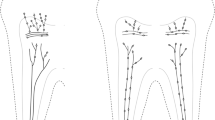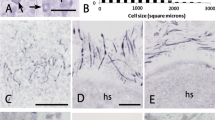Summary
Nerve growth factor receptor immunoreactivity (NGFR-IR) in sensory nerves and somatosensory receptors of adult rat dental and periodontal tissue was analysed using a monoclonal antibody (192-IgG) and electron microscopy. In dental and periodontal nerves, the unmyelinated axons and their Schwann cells had occasional labelling of their cell membranes, and myelinated axons had none. Dental free nerve endings in predentin had varied NGFR-IR: 15% were unlabelled, 25% had some axonal membrane NGFR-IR, and 60% had intense membrane label and cytoplasmic staining. In periodontal ligament there were two types of NGFR-IR somatosensory receptors: Ruffini mechanoreceptors had extensive NGFR-IR on apposed membranes of the terminal Schwann cell and nerve endings, but no labelling of the neural fingers which extended out into the ligament tissue; and thin fibres had intense membrane NGFR-IR and cytoplasmic stain.
Non-neuronal NGFR-IR had cell specific patterns: perineurial and endoneurial cells and Ruffini terminal Schwann cells had NGFR-IR on cell membranes and inside numerous pinocytotic vesicles; Schwann cells along unmyelinated axons had NGFR-IR cell membrane intensities which varied depending on the NGFR-IR intensity of the enclosed axons; odontoblasts were unlabelled except at sites of contact with the NGFR-IR pulpal or neural cells; pulp fibroblasts in the subodontoblast zone had intense NGFR-IR all along their cell membrane; and ligament fibroblasts were unlabelled.
The diverse NGFR-IR patterns described here suggest that there are specific categories of cellular expression and localization which correlate with somatosensory receptor type, and that specific patterns also characterize various non-neuronal cells in dental and periodontal tissue. Only the endoneurial cells, perineurial cells, and Ruffini terminal Schwann cells had NGFR-IR endocytotic vesicles, suggesting NGF internalization by high-affinity receptors.
Similar content being viewed by others
References
Andres, K. H. &Von During, M. (1973) Morphology of cutaneous receptors. InSomatosensory System. Handbook of Sensory Physiology (edited byIggo, A.) Vol. II, pp. 3–28. Berlin: Springer-Verlag.
Beaudreau, D. E. &Jerge, C. R. (1968) Somatotopic representation in the gasserian ganglion of tactile peripheral fields in the cat.Archives of oral Biology 13, 247–56.
Bernd, P. &Greene, L. A. (1984) Association of125I-NGF with PC12 pheochromocytoma cells. Evidence for internalization via high-affinity receptors only and for long term regulation by NGF of both high- and low-affinity receptors.Journal of Biological Chemistry 259, 15509–16.
Biemesderfer, D., Munger, B., Binck, J. &Dubner, R. (1978) The pilo-Ruffini complex: A non-sinus hair and associated slowly adapting mechanoreceptor in primate facial skin.Brain Research 142, 197–222.
Bothwell, M. (1989) Characterization of NGF receptors. InNerve Growth Factors (edited byRush, R. A.) pp. 299–313. New York: John Wiley & Sons.
Byers, M. R. (1984) Dental sensory receptors.International Review of Neurobiology 25, 39–94.
Byers, M. R. (1985) Sensory innervation of periodontal ligament of rat molars consists of unencapsulated Ruffinilike mechanoreceptors and free nerve endings.Journal of Comparative Neurology 231, 500–18.
Byers, M. R., Bothwell, M., Mecifi, K. B. &Schatteman, G. C. (1988) Interactions of nerves and pulp cells in normal and injured teeth analyzed by LM and EM immunocytochemistry for NGF receptors.Society for Neuroscience Abstracts 14, 1167.
Byers, M. R. &Dong, W. K. (1989) Comparison of trigeminal receptor locations and structure in the periodontal ligament of different types of teeth from the rat, cat and monkey.Journal of Comparative Neurology 279, 117–27.
Byers, M. R., O'Lonnor, T. A., Martin, R. F. &Dong, W. K. (1986) Mesencephalic trigeminal sensory neurons of cat: axon pathways and structure of mechanoreceptive endings in periodontal ligament.Journal of Comparative Neurology 250, 181–91.
Byers, M. R., Schatteman, G. C. &Bothwell, M. (1990) Multiple functions for NGF receptor in developing, aging and injured rat teeth are suggested by epithelial, mesenchymal and neural immunoreactivity.Development 109, 461–71.
Byers, M. R. &Yeh, Y. (1984) Fine structure of subepithelial ‘free’ and corpuscular trigeminal nerve endings in the anterior hard palate of the rat.Somatosensory Research 1, 265–79.
Chandler, C. E., Parsons, L. M., Hosang, M. &Shooter, E. M. (1984) A monoclonal antibody modulates the interaction of nerve growth factor with PC12 cells.Journal of Biological Chemistry 259, 6882–5.
Chesa, P. G., Rettig, W. J., Thomson, T. M., Old, L. J. &Melamed, M. R. (1988) Immunohistochemical analysis of nerve growth factor receptor expression in normal and malignant human tissue.Journal of Histochemistry Cytochemistry 36, 383–9.
Claude, P. A., Hawrot, E., Dunis, D. A. &Campenot, R. B. (1982) Binding internalization and retrograde transport of125I-NGF in cultured rat sympathetic neurons.Journal of Neuroscience 2, 431–42.
Distefano, P. S. &Johnson, E. M. (1988) Nerve growth factor receptors on cultured rat Schwann cells.Journal of Neuroscience 8, 231–41.
Dong, W. K., Chudler, E. &Martin, R. F. (1985) Physiological properties of intradental mechanoreceptors.Brain Research 334, 389–95.
Dumas, M., Schwab, M. E. &Thoenen, H. (1979) Retrograde axonal transport of specific macromolecules as a tool for characterizing nerve terminal membranes.Journal of Neurobiology 10, 179–97.
Fried, K. &Hildebrand, C. (1981) Pulpal axons in developing, mature and aging feline permament incisors. A study by electron microscopy.Journal of Comparative Neurology 203, 23–36.
Gunji, T. (1982) Morphological research on the sensitivity of dentin.Archivum histologicum Japonicum 45, 45–67.
Jerge, C. R. (1963) Organization and function of the trigeminal mesencephalic nucleus.Journal of Neurophysiology 26, 379–92.
Johnson, E. M., Taniuchi, M. &Distefano, P. S. (1987) Expression and possible function of nerve growth factor receptors on Schwann cells.Trends in Neurosciences 7, 299–304.
Jontell, M., Bergenholtz, G., Scheynius, A. &Ambrose, W. (1988) Dendritic cells and macrophages expressing class II antigens in the normal rat incisor pulp.Journal of Dental Research 67, 1263–6.
Kimberly, C. L. &Byers, M. R. (1988) Inflammation of rat molar pulp and periodontium causes increased calcitonin gene-related peptide and axonal sprouting.Anatomical Record 222, 289–300.
Levi-Montalcini, R. (1987) The nerve growth factor: 35 years later.Science 237, 1154–62.
Maeda, T., Iwanaga, T., Fujita, T. &Kobayashi, S. (1986) Immunohistochemical demonstration of nerves in the predentin and dentin of human third molars with the use of an antiserum against neurofilament protein. (NFP).Cell and Tissue Research 243, 469–73.
Maeda, T., Sato, O., Kobayashi, S., Iwanaga, T. &Fujita, T. (1989) The ultrastructure of Ruffini endings in the periodontal ligament of rat incisors with special reference to the terminal Schwann cells (K-cells).Anatomical Record 223, 95–103.
Mazurek, N., Weskemp, G., Erne, P. &Otten, U. (1986) Nerve growth factor induces mast cell degranulation without changing intracellular calcium levels.FEBS Letters 198, 315–20.
Mei, N., Hartmann, F. &Aubert, M. (1977) Periodontal mechanoreceptors involved in pain. InPain in the Trigeminal Area (edited byAnderson, D. J. andMatthews, B.) pp. 103–10. Amsterdam: Elsevier.
Närhi, M. (1985) The characteristics of intradental sensory units and their responses to stimulation.Journal of Dental Research 64 (Special Issue), 564–71.
Raivich, G., Zimmermann, A. &Sutter, A. (1985) The spatial and temporal pattern of β-NGF receptor expression in the developing chick embryo.EMBO Journal 4, 637–44.
Repressa, J. &Bernd, P. (1989) Nerve growth factor and serum differentially regulate development of the embryonic otic vesicle and cochleovestibular ganglionin vivo.Developmental Biology 134, 21–9.
Ribiero Da Silva, A., Kenigsberg, R. L. &Cuello, A. C. (1988) Nerve growth factor receptor immunoreactivity present in axons and epithelial cells of the rat skin.Society for Neuroscience Abstracts 14, 903.
Ross, A. H., Grob, P., Bothwell, M., Elder, D. E., Ernst, C. S., Marano, N., Ghrist, B. F. D., Slemp, C. C., Herlyn, M., Atkinson, B. &Koprowski, H. (1984) Characterization of nerve growth factor receptor in neural crest tumors using monoclonal antibodies.Proceedings of the National Academy of Sciences (USA) 81, 6681–5.
Silverman, J. D. &Kruger, L. (1987) An interpretation of dental innervation based upon the pattern of calcitonin gene-related peptide (CGRP)-immunoreactive thin sensory axons.Somatosensory Research 5, 157–75.
Silverman, J. D. &Kruger, L. (1989) Calcitonin-generelated- peptide-immunoreactive innervation of the rat head with emphasis on specialized sensory structures.Journal of Comparative Neurology 280, 303–30.
Stach, R. W. &Perez-Polo, I. R. (1987) Binding of nerve growth factor to its receptor.Journal of Neuroscience Research 17, 1–10.
Taniuchi, M., Clark, H. B., Schweitzer, J. B. &Johnson, E. M. (1988) Expression of nerve growth factor receptors by Schwann cells of axotomized peripheral nerves: Ultrastructural location, suppression by axonal contact and binding properties.Journal of Neuroscience 8, 664–81.
Thompson, S. J., Schatteman, G. C., Gown, A. M. &Bothwell, M. (1989) A monoclonal antibody against nerve growth factor receptor: Immunohistochemical analysis of normal and neoplastic human tissue.American Journal of Clinical Pathology 92, 415–23.
Yan, Q. &Johnson, E. M. (1988) An immunohistochemical study of the nerve growth factor receptor in developing rats.Journal of Neuroscience 8, 3481–98.
Author information
Authors and Affiliations
Rights and permissions
About this article
Cite this article
Byers, M.R. Segregation of NGF receptor in sensory receptors, nerves and local cells of teeth and periodontium demonstrated by EM immunocytochemistry. J Neurocytol 19, 765–775 (1990). https://doi.org/10.1007/BF01188044
Issue Date:
DOI: https://doi.org/10.1007/BF01188044




